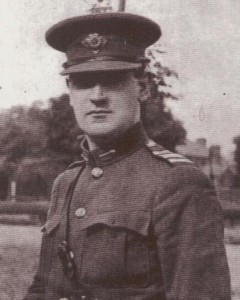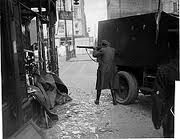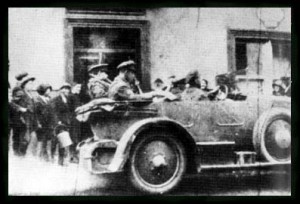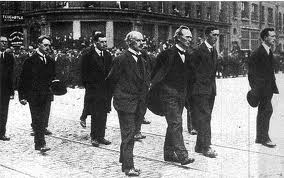Today in Irish History – August 22, 1922 – Béal na Bláth, The Shooting Of Michael Collins

The death of Michael Collins, by John Dorney.
On a country road in West Cork, on August 22 1922, a convoy of green uniformed National Army troops encountered barricade on a curve in the road near the townland of Beal na Blath.
Shots rang out from the overlooking hillside. Fire had been opened on them by anti-Treaty IRA guerrillas. At some point during the one hour fire fight, a lone figure, who had been returning fire with a rifle, was hit in the head and killed.
It was National Army commander in Chief Michael Collins.
Not since, perhaps, the death of Brian Boru at the battle of Clontarf in 1014 has the violent death of an Irish leader been so lamented in Irish popular memory. Collins, killed at just 32, remains to this day, the ‘lost leader’.
Michael Collins had been the IRA Director of Intelligence, Minister for Finance of the underground Republican government of 1919-21 and, unofficially, the leading figure in the independence struggle against the British.
After he, Arthur Griffith and the other negotiators had signed the Anglo-Irish Treaty however, in December 1921, he found himself head of the Provisional Government of the Irish Free State, on the opposite side of bitter split with former comrades, who held out for a fully independent Irish Republic.
He tried earnestly to avoid armed conflict breaking over the Treaty in the first six months of 1922. But on June 28 1922, when he ordered Free State forces to open fire on the anti-Treaty stronghold of the Four Courts in Dublin, he found himself leading pro-Treaty forces in a fratricidal Civil War.
It was these circumstances that led to his death at Beal na Blath on August 22, 1922.
Civil War

Free State forces secured Dublin city after a week of hard fighting from June 28 to July 5 1922 in what Collins hoped would be a swift and decisive end to armed opposition to the Provisional Government.
Unfortunately for Collins, the anti-Treaty IRA under Liam Lynch, occupying most of the provinces in the south and west, now dug in for a long war.
Though it was clear by the second week of July that the Civil War could not be confined to Dublin, Collins and his lieutenants still hoped to wrap it up in short order with a swift offensive to retake towns and cities held by the anti-Treaty IRA. Gearoid O’Sullivan, the Army Adjutant General told Cabinet that, ‘the Irregulars all over the country could be disposed of in a week or a fortnight’.[1]
Collins hoped that a swift military campaign followed by peace talks with the anti-Treatyites could end the Civil War within a month.
A whirlwind campaign in July saw anti-Treaty positions across most of the country, from Drogheda to Donegal to Waterford fall to Free State troops.
On July 26 Collins was able to write to his colleagues, ‘we may congratulate ourselves that everything has turned out so well… we have taught the rebels lessons… which appeals to reason or patriotism failed to teach them’. It remained to dislodge the ‘Irregulars’ in their stronghold of Cork and Kerry and Collins hoped to do so by a swift knock down blow that would ‘save the good fighting men of Cork from barrenness of their leaders’ who ‘have shown themselves to be without an objective’. [2]
The Cork and Kerry Landings
To this end, he and Army commander Emmet Dalton planned two seaborne expeditions to Cork and Kerry in the first week of August 1922, landing on the southern coast outflanking the ongoing fighting line in counties Limerick and Tipperary.
The National Army duly landed by sea, first in Kerry on August 3rd and then at three points near Cork city on August 8th.
Several thousand troops were landed on the southern coast and though there was some hard fighting, within a week Cork city and most of the important towns in south Munster were in government hands, though at a cost of 18 Free State soldiers killed and dozens more wounded.
Michael Collins found the funeral ceremonies at Glasnevin Cemetery for the dead soldiers, killed in the Cork and Kerry landings, most trying, and was particularly upset by the grief of the mothers of some of the young soldiers. Still, he and his colleagues now assumed the war was over. Surely the ‘Irregulars’ would now come in, hand over their weapons and respect the authority of the government?
Free State troops wrested the main towns in Cork and Kerry from the Republicans in August 1922.
The problem was that his opposite number, anti-Treaty IRA Chief of Staff Liam Lynch, was not at all pessimistic. From the start he had anticipated a return to guerrilla warfare to bring down the Free State.
In response to peace feelers on August 4th Lynch wrote to Collins; ‘defensive action will cease when the Provisional Government attacks on us cease’. To which Collins replied, ‘’The time for face-saving is passed, the choice is between the return of the British and the Irregulars sending in their arms to the people’s government’.[3]
There may have been an anti-Treaty policy to try to kill Collins. In Dublin the week before the fatal ambush at Beal na Blath, his official car (though he was not in it) was caught in an ambush at Stillorgan south of the city; a gun and grenade attack in which his driver was wounded in the hip. Collins indignantly dashed off a note to the National Army Publicity Department enquiring why the incident was not publicised. He had told a Government meeting of the attack, he complained, ‘but apparently it was not of sufficient interest for publication’.[4]
The ambush at Beal na Blath

The Commander in Chief in the meantime had travelled to Cork and had been inspecting the recently secured countryside in his native county.
He seems also to have hoped to use his personal contacts with Republican guerrillas for peace talks to, ‘put an end to the damned thing’. ‘The three Toms’ he said (Tom Barry, Tom Hales and Tom Malone) ‘will fix it’[5].
Collins was on a return journey from Bandon to Macroom in West Cork, when he fell into an ambush commanded by Liam Deasy.
Deasy noted in his report to Liam Lynch that Collins, in a motorised convoy of 30 soldiers, accompanied by an armoured car, passed the townland of Beal na Blath early on the morning of August 22 and ‘Michael Collins travelled in the touring car’ and ‘made himself very prominent’.
Liam Deasy commanded the fatal ambush party at Beal na Blath
Deasy, with 32 guerrillas, barricaded the road and set up an ambush position on the overlooking hillside, in the hope that Collins’ party would make the unwise decision to return to Bandon by the same route. They lay in ambush all day until 7:45 that evening when, on hearing that their target had gone to Clonakilty, most of the anti-Treatyites retired for the night. Only six IRA men were still at the ambush site when Collins’ column indeed appeared and was held up at the barricade.
The six guerrillas opened fire. While the other ambushers scrambled to get back to the firing line, most of them were pinned down by machine gun fire and ‘unable to render any real assistance’.
According to Deasy, ‘the firing was terrific, the enemy relied chiefly on his machine gun. Now and again you could hear the cracking of rifle fire from the little party… the engagement lasted one hour. The enemy managed to remove the barricade… [and] they beat a retreat’.
‘I have since learned that Michael Collins was shot dead during the engagement’. Our casualties were nil.’[6]
Collins’ convoy had a Rolls Royce armoured car in which he would have been perfectly safe from bullets during the firefight, or they could, as Emmet Dalton advised at the time – have simply ‘driven like hell’ out of the ambush site – going back the way they had come if the way forward was blocked.
For some reason Collins did neither, ordered his men to stop and fight and got out of the touring car to join in the firefight himself. While firing away with a rifle, he was hit by bullet in the head, and died almost instantly.
There are an almost infinite number of theories on who fired the fatal bullet and whether there was some sort of grand conspiracy between the Republicans, Free State troops and the British. But it seems most likely that the Collins was just hit by a random bullet in a fire fight, according to Meda Ryan’s research, it was fired by a local man named Dennis “Sonny” O’Neill.[7]
Collins body, brought back to Dublin by sea, after a tortuous overland trip to Cork city, saw one of the city’s largest ever public funerals, a huge crowd lined the route to Glasnevin cemetery, where he was interred after volleys of rifle shots were fired over the grave by National Army troops.
Reactions: ‘The Big Fella is Dead’

In public at least, many anti-Treaty Republicans regretted Collins’ death. Liam Lynch wrote, ‘it is indeed a regrettable National Position – which nothing could better illustrate – that makes the shooting of such leaders and with such a splendid previous record necessary’[8].
Liam Deasy wrote in his memoir in later years, ‘his death caused nothing but the deepest sorrow and regret and brought about in many of us a real desire for the end of the war’[9].
In private though, many anti-Treaty Republicans were upbeat. The death of Collins and upsurge in guerrilla attacks around the country in late August and September 1922, made all sides in the conflict think that the Free State was on the ropes.
In the initial aftermath of Collins death, many thought that the Free State would collapse.
In Mountjoy Prison, imprisoned anti-Treaty leader Joe McKelvey wrote to Ernie O’Malley, ‘All seems to be going well outside. The Free State here are terribly cut up about Mick. They seem to be absolutely lost.’ The Deputy Governor of the Prison Paudeen O’Keefe said, ‘the British would be back in a week. He was quite serious’.[10]
The British military, still with a substantial garrison in Dublin and at the ‘Treaty ports’ at Cobh, Bearhaven and Lough Swilly, concurred, one Intelligence officer in Dublin reporting that in the wake of Collins’ death, ‘The P.G. [Provisional Government] officers are very despondent’.
WT Cosgrave, in their estimation, was ‘capable and sincere’ but not up to the job of restoring order’. By September they were reporting, ‘Having crushed the massed resistance of the Republicans, PG troops now find themselves faced with a guerrilla campaign which every day becomes more effective.’[11]
As it happened, however, power in the Free State had passed to a young, but tough and ruthless leadership. Richard Mulcahy took over as Commander in Chief of the Army and WT Cosgrave, who had been Minister for Local Government, as head of Government. Patrick Hogan, Minister for Agriculture and Kevin O’Higgins, the Minister for Justice also rose to prominence in Collins’ and Arthur Griffith (who had died the week before)’s absence.
They, much more than Collins, would prove ruthless in their use of executions and internment to crush anti-Treaty resistance by May of 1923.
Richard Mulcahy appealed to the Army for ‘no cruel act of reprisal’ for Collins death. But many anti-Treaty Republicans thought that Collins’ death allowed the ‘hard men’ of his pro-Treaty IRA followers in the National Army a free reign to carry out reprisals. Alfred White, a Fianna officer speaking of Free State forces in Dublin commented sourly, ‘The death of Collins removed the only man who could control them’.[12] Frank Sherwin thought ‘After Collins was killed, the murder gang took over, protected by members of the government’.[13]
In later years, Collins, who lost his life just short of his 32nd birthday, has attained the status of the great lost leader to some and that of a traitor to others. While some think of him as the great peacemaker who would have led Ireland to peaceful and progressive modernity, or perhaps to a united Ireland, others, less convinced of his peaceable and democratic intentions, see him as a potential military dictator in the making.
But on the day itself, the most common reaction, certainly among his own men, was shock and grief.
Bernard O’Byrne recalled, ‘it was like the end of the world, something that you loved and believed in was gone’. Emmet Dalton asked Piaras Beaslai, the Free State’s Director of Publicity when telling him of Collins’ death, ‘what on earth am I to do?
Gearoid O’Sullivan broke down in tears telling Army officer Charlie Dalton, ‘Charlie the Big Fella is dead’.[14]
References
[1] Ernest Blythe BMH
[2] Collins memo on General Situation 27/7/22 Mulcahy Papers, P/7/B29
[3] De Valera Papers P150/1647
[4] Letter from Collins 19/8/1922 Kathleen McKenna Papers, National Library of Ireland NLI MS,22,779
[5] Meda Ryan, Tom Barry, IRA Freedom Fighter, p.179
[6] Deasy’s report to Lynch, dated 27 August 1922 is located in the Twomey papers, UCD and is reproduced in ful in Brian Hanley, the IRA, A Documentary History, p.48-49
[7]Meda Ryan, The Day Michael Collins was shot, p125
[8] Cormac KH O’Malley, Anne Dolan (ed.s), No Surrenders Here! The Civil War Papers of Ernie O’Malley, p135
[9] Liam Deasy, Brother Against Brother p.81
[10] Mulcahy Papers P7/B/83 McKelvey to EOM 28/8/1922
[11] British Intelligence reports August to September 1922 in De Valera Papers P150/1646
[12] Alfred White BMH WS 1207
[13] Frank Sherwin, Independent and Unrepentant p 15
[14] Boyne, Emmet Dalton, p235-236